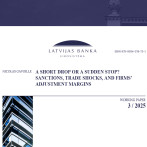Gross domestic product of the fourth quarter: a story of several villains

Just a year ago the gross domestic product (GDP) defeated the sombre pessimism of forecasters by showing better growth in the circumstances of the pandemic. Now, however, it has confirmed, even surpassed, the pessimistic forecasts. What is the cause of the weaker growth in 2021? The list of the factors could be long, and some of them already have a history, but here we will deal with the fourth quarter developments.
Besides, it should be noted that we are focusing on the end of 2021. When listening to the New Year speeches, it seems, no one could even imagine that the period of almost two years of the exhausting Covid-19 pandemic would turn out to be a relatively nice page in our lives and February 2022 (in the person of a mentally unbalanced and aggressive neighbour) would bring along a major geopolitical disaster.
Consequently, neither these data nor the respective forecasts take into account the effects of the Russian invasion of Ukraine, and such effects are definitely there.
Returning to memories of the fourth quarter of 2021, the dynamics of the economy may be characterised by a saying that we have that whatever we are trying to save up is eventually taken by a robber, this time called inflation. This is the way how one could describe the future of our savings generated during the lock-down constraints, i.e. spending these savings on more expensive goods makes the real consumption growth more moderate than previously expected.
Cost increases also plunder the planned investment budgets, making certain projects unrealisable. Therefore, investment is also growing more slowly than one would have desired: there is a certain marked increase in monetary terms, while the implementation of real projects is more modest.
Inflation, to a large extent, is a global saboteur now reaching us mainly through the growing energy prices. However, there are a couple of ways that we are doing harm to ourselves. Namely, the following factors hamper the growth of Latvia's economy and enable economies of other countries to grow faster:
- Increase in spending abroad, fleeing from the pandemic to the lands that enjoy more sun and freedom (now this word has obtained a much broader connotation in our perception), as evidenced by the payment card statistics of Latvijas Banka;
- It is difficult to overlook the profound disbalance in the manufacturing sector with growing revenues from exported products and the sluggish domestic trade. I would suggest two explanations to this fact: a) the already mentioned restrictions introduced in November); b) this autumn, Latvia's major retailers were joined by Lidl selling local canned fish and eggs, but milk and many other local products are not on sale there; consequently, the demand for domestic products is decreasing.
Comment on Lidl. Although the poor presence of domestic products deeply hurts my patriotic feelings, I can understand the objective considerations of the trader and I believe that this could serve as an incentive for domestic producers to strive to improve their competitiveness and, in the long term, result in a stronger development.
Unfortunately, inflation will continue robbing us in the near future, but, for now, it has lost its status as the main villains, as the real perpetrator is the aggressor Russia and its henchman Belarus, and the future currently seems to be unclear and full of new challenges to our economy.
Data based on Official Statistics of Latvia
Textual error
«… …»






